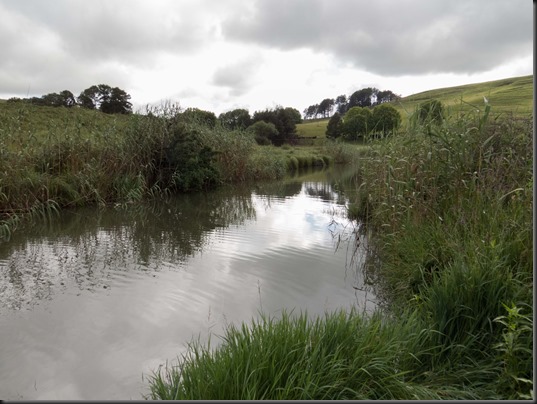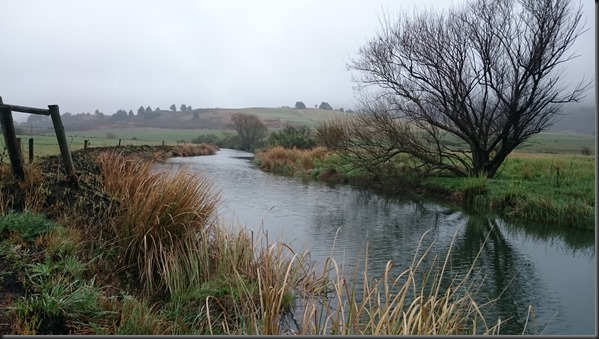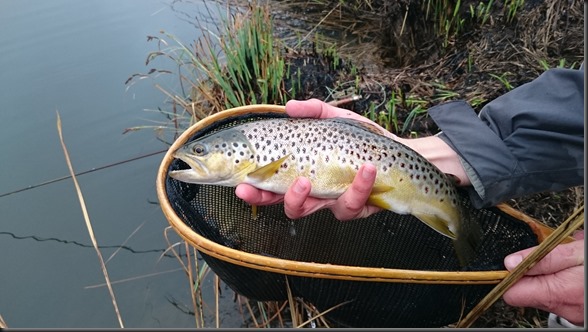“Opening Day – 1 September 1990”
After a winter of repeated tackle cleaning, fly tying and general pent-up abstinence, fly fishermen, myself included, seldom miss an opening day of the season.
It was the first day of spring and we were to have the privilege of fishing a small stretch of the upper Umgeni River. The old Merc bumped, lurched and scraped its belly down the stony track towards the farm “Knowhere”, with its large house overlooking the bend in the long pool and the downstream flats along the southern bank of the river dotted with grazing sheep. We parked by the side of the track near the top of the hill, briefly admiring the idyllic setting below us, then opted to walk the last few hundred metres to the farmhouse rather than risk doing serious damage to the underside of the car.

After exchanging courtesies with the friendly landowner and fending off three large, overenthusiastic farm dogs, we were at last free to stroll down to the river bank to see what condition the water was in following some early spring rain two days before. The river level had risen and, while slightly off colour, was just clean enough so one could see the fly in the water and just discoloured and turbulent enough to allow fishing from the high banks without being spotted by the wily browns that live in this stretch of river.
I rigged up a five-weight outfit for my girlfriend Jacqui and a three-weight for myself. The leaders were topped with small, bright orange foam strike indicators and the light tippets finished off with a freshly tied “Peacock Woolly Worm” on the five-weight, and the three-weight with my favourite “Wezani” nymph. The Wezani is a somewhat simple, but very effective, olive green and black seal’s fur nymph that Paul de Wet and I had developed and refined on several trips to the forested streams above Weza in southern Natal. The Wezani is best tied well weighted with wine bottle lead, or with plumber’s lead if you don’t drink wine. These flies seem to improve after catching a couple of fish when they become more tattered around the thorax.
Within the first hour or two of the morning’s fishing I caught and released a number of small, feisty browns around half to three-quarters of a pound. They were typical ‘geni browns – beautifully coloured and healthy. The fish were eager and hungry after the long winter but, as usual, tricky and evasive.
Approaching midday, I wandered over to the high bank from which Jacqui had been casting to hear that she had just hooked and lost her first ever brown trout. She appeared to be taking it quite well and wasn’t nearly as distraught as I would have been. I sensed that I would only be getting in her way and that any offers of consolation or tuition would not likely be welcomed, so I continued a short distance downstream and squatted down behind a clump of bush to continue the steady rhythm of casting and drifting the nymph slow and deep along the bank.
The foam strike indicator dipped once more, but this time more decisively, and disappeared into the green depths. I lifted the rod gently and struck hard. A large, brightly speckled brown more than half a metre long flashed its long flanks, writhed and then dived to the bottom of the stream. The soft little rod bucked hard and my road arm trembled as the fish thumped and knocked against the stream bed and then dived headlong into some submerged reeds against the opposite bank. It showed itself on the surface one more time and then sounded again.
Almost half an hour later after a dogged battle interspersed with powerful runs, we beached the grand old fish into a clump of weed about a hundred metres downstream. As I reached down to slip my index finger into its gills, the small fly shot out of its mouth with an audible “ping”. I jumped into the water up to my thighs and, using both arms, scooped the exhausted monster onto the bank. With some sadness, I reluctantly administered the Coup de Grace. It was well beyond reviving after the unnecessarily long fight. I had not come prepared for fish this size.
The old cockfish was long and wiry with a large head, a pronounced rounded snout and a hooked jaw. His big, round spots were charcoal-coloured, with some bright red ones surrounded here and there by large silver rosettes. It was stunning. Measuring 57cm and weighing 3lb 15oz., it was my largest brown and by far the biggest stream fish I had ever seen, or had ever hoped to see on any trout water.
Those of you who have fished this stretch of the Umgeni River will probably agree that its landscape and the very long, slow pools around its middle section are quite unlike other classic ‘berg and midlands waterways.

Under normal water levels, this section is typically slack or at best slow-flowing and there are no riffles or fast water to impart movement and action to your fly, or to excite the downstream angler. The high banks demand a stealthy, upstream approach and the fish, while fairly plentiful, can at times be a real challenge. A good measure of patience, concentration and sharp reflexes are required as you crane your neck watching your barely moving leader, waiting and begging the strike indicator to stop and dip into the murky depths. And then you pick up the line and repeat the exercise, cast after cast.
Strike indicators are a matter of personal preference. I don’t mind them and in situations like this I like to use a small polypropylene yarn or a stick-on foam indicator at the very top of a short leader, typically 7 to 8 foot long. Just about any small nymph will do the job, but after several trips to this part of the Umgeni I can vouch for a generic Peacock Woolly Worm in sizes 10 and 12 as a confidence-boosting, backup pattern when the water is dirty, and a well weighted Wezani (or similar) nymph in sizes 12, 14 and 16 to cover various depths to structure when the water is on the clean side.
The beautiful early spring day was capped off when Jacqui eventually landed her first Umgeni brown late that afternoon after several frustrating near-misses. Around sunset, we trudged wearily but contented back up the steep hill and turned the car homeward to “sticky troutless, Durban”* (with sincere apologies to Neville Nuttall).
On the drive home, my thoughts inevitably returned to the day and it was only then that I remembered the 3lb 10oz. fish that Paul de Wet had caught on a nearby stretch of the Umgeni the year before and the apparently much larger fish that our friend Conrad Raab had lost earlier in the 1988 season. While the Umgeni is certainly better known for its browns of half a pound or sometimes up to a pound if you are lucky, 2 pounders are not unheard of and, as we now know, a trophy fish is never out of the question.

This is indeed a special and very different stretch of river and only a small part of a much larger, diverse waterway that demands our time and exploration.
Brett is an old friend, who now resides in Australia with his wife Jacqui.
Photos supplied by Andrew are more recent, but were all taken on the stretch of river in question: “Knowhere”, which is now NFFC club water.